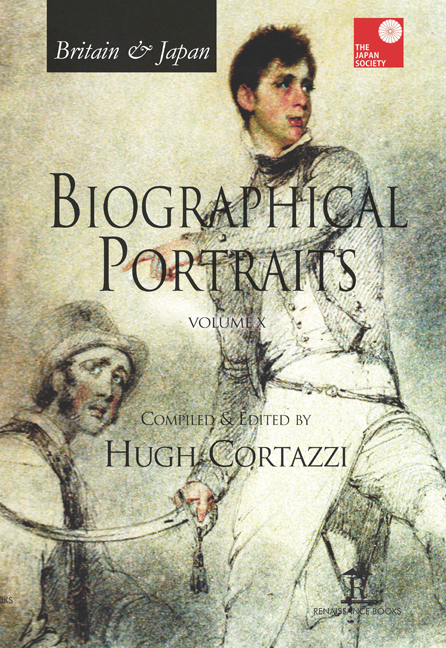Book contents
- Frontmatter
- Dedication
- Contents
- Introduction
- List of Contributors
- Index of Biographical Portraits in Japan Society Volumes
- PART I BRITAIN IN JAPAN
- PART II JAPAN IN BRITAIN
- Select Bibliography of Works in English on Anglo-Japanese Relations [Compiled by Gill Goddard – Retired East Asian Studies Librarian, University of Sheffield]
- Select Bibliography of Works in Japanese on Anglo-Japanese Relations [Compiled by Akira Hirano, SISJAC]
- Index
62 - Bonsai in Britain
Published online by Cambridge University Press: 07 May 2022
- Frontmatter
- Dedication
- Contents
- Introduction
- List of Contributors
- Index of Biographical Portraits in Japan Society Volumes
- PART I BRITAIN IN JAPAN
- PART II JAPAN IN BRITAIN
- Select Bibliography of Works in English on Anglo-Japanese Relations [Compiled by Gill Goddard – Retired East Asian Studies Librarian, University of Sheffield]
- Select Bibliography of Works in Japanese on Anglo-Japanese Relations [Compiled by Akira Hirano, SISJAC]
- Index
Summary
INTRODUCTION
THE NIPPON BONSAI Association declares that a bonsai is ‘a wondrous thing: in less space than a man can encompass with his arms, it can suggest a whole world of venerable old trees’. It has also been described as an ‘artistic pot plant’ or ‘a tree or shrub trained and pruned in such a way as to resemble a full-size tree, grown in a shallow container for artistic effect and as an impression of nature’.
The word bonsai is an approximation in English to the Japanese reading of two Chinese ideographs: where the first character is read as ‘bon’ meaning a tray, container or pot and the second character read as ‘sai’ meaning a plant or planting. In Chinese the characters were read as ‘punchai’ until China adopted the modern system of romanization and were read as ‘penjing’. The term bonsai covers a number of allied art forms and subdivisions but was not adopted as the descriptive noun in English until the beginning of the twentieth century.
Towards the end of the twentieth century many of the cheap bonsai on sale in supermarkets and garden centres in Europe came from southern China and thus were penjing.
HISTORY
It is probable that the concept of bonsai – a potted plant (or plants) trained and cultivated, to some degree at least, so as to give the object added artistic and metaphysical significance originated in China at least 2,000 years ago.
It is not clear precisely when the concept of growing dwarfed trees in containers arrived in Japan. The earliest reference in Japanese literature is said to be in the Utsubo Monogatari (The Tale of the Hollow Tree) in the late tenth century – ‘A tree that is left growing in its natural state is a crude thing. It is only when it is kept close to human beings, who fashion it with loving care, that its shape and style acquire the ability to move one.’ But was it in a pot?
The earliest pictorial evidence in Japan is from the thirteenth century. But it is generally accepted that what would now be called bonsai arrived in Japan during the Heian period.5 However, the term bonsai does not appear in Japanese literature until the seventeenth century. Until then what are now called bonsai were referred to as hachi-no-ichi (potted plants).
- Type
- Chapter
- Information
- Britain & Japan Biographical Portraits Vol X , pp. 705 - 717Publisher: Amsterdam University PressPrint publication year: 2016

